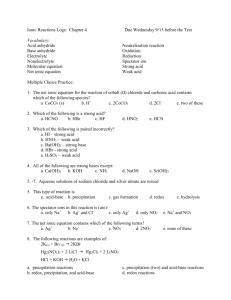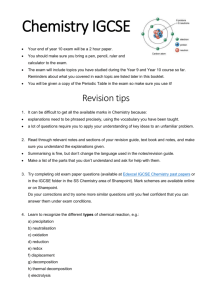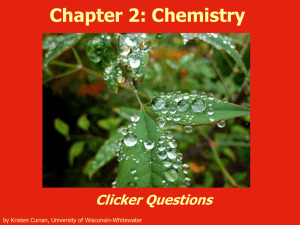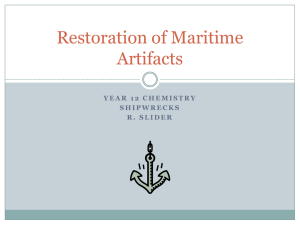PHYSICAL PROPERTIES OF THE PERIOD 3 OXIDES
advertisement
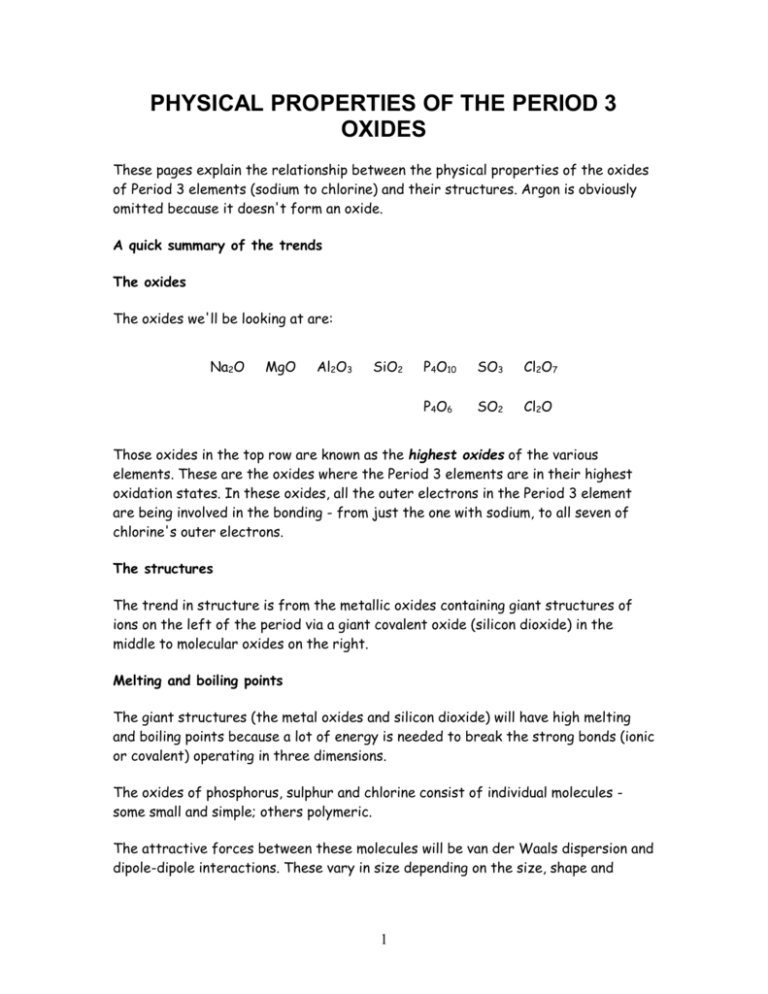
PHYSICAL PROPERTIES OF THE PERIOD 3 OXIDES These pages explain the relationship between the physical properties of the oxides of Period 3 elements (sodium to chlorine) and their structures. Argon is obviously omitted because it doesn't form an oxide. A quick summary of the trends The oxides The oxides we'll be looking at are: Na2O MgO Al2O3 SiO2 P4O10 SO3 Cl2O7 P4O6 SO2 Cl2O Those oxides in the top row are known as the highest oxides of the various elements. These are the oxides where the Period 3 elements are in their highest oxidation states. In these oxides, all the outer electrons in the Period 3 element are being involved in the bonding - from just the one with sodium, to all seven of chlorine's outer electrons. The structures The trend in structure is from the metallic oxides containing giant structures of ions on the left of the period via a giant covalent oxide (silicon dioxide) in the middle to molecular oxides on the right. Melting and boiling points The giant structures (the metal oxides and silicon dioxide) will have high melting and boiling points because a lot of energy is needed to break the strong bonds (ionic or covalent) operating in three dimensions. The oxides of phosphorus, sulphur and chlorine consist of individual molecules some small and simple; others polymeric. The attractive forces between these molecules will be van der Waals dispersion and dipole-dipole interactions. These vary in size depending on the size, shape and 1 polarity of the various molecules - but will always be much weaker than the ionic or covalent bonds you need to break in a giant structure. These oxides tend to be gases, liquids or low melting point solids. Electrical conductivity None of these oxides has any free or mobile electrons. That means that none of them will conduct electricity when they are solid. The ionic oxides can, however, undergo electrolysis when they are molten. They can conduct electricity because of the movement of the ions towards the electrodes and the discharge of the ions when they get there. The metallic oxides The structures Sodium, magnesium and aluminum oxides consist of giant structures containing metal ions and oxide ions. Melting and boiling points There are strong attractions between the ions in each of these oxides and these attractions need a lot of heat energy to break. These oxides therefore have high melting and boiling points. Electrical conductivity None of these conducts electricity in the solid state, but electrolysis is possible if they are molten. They conduct electricity because of the movement and discharge of the ions present. The only important example of this is in the electrolysis of aluminum oxide in the manufacture of aluminum. Whether you can electrolyze molten sodium oxide depends, of course, on whether it actually melts instead of subliming or decomposing under ordinary circumstances. If it sublimes, you won't get any liquid to electrolyze! Magnesium and aluminum oxides have melting points far too high to be able to electrolyze them in a simple lab. 2 Silicon dioxide (silicon(IV) oxide) The structure The electronegativity of the elements increases as you go across the period, and by the time you get to silicon, there isn't enough electronegativity difference between the silicon and the oxygen to form an ionic bond. Silicon dioxide is a giant covalent structure. There are three different crystal forms of silicon dioxide. The easiest one to remember and draw is based on the diamond structure. Melting and boiling points Silicon dioxide has a high melting point - varying depending on what the particular structure is (remember that the structure given is only one of three possible structures), but they are all around 1700°C. Very strong silicon-oxygen covalent bonds have to be broken throughout the structure before melting occurs. Silicon dioxide boils at 2230°C. Because you are talking about a different form of bonding, it doesn't make sense to try to compare these values directly with the metallic oxides. What you can safely say is that because the metallic oxides and silicon dioxide have giant structures, the melting and boiling points are all high. Electrical conductivity Silicon dioxide doesn't have any mobile electrons or ions - so it doesn't conduct electricity either as a solid or a liquid. The molecular oxides Phosphorus, sulphur and chlorine all form oxides which consist of molecules. Some of these molecules are fairly simple - others are polymeric. We are just going to look at some of the simple ones. Melting and boiling points of these oxides will be much lower than those of the metal oxides or silicon dioxide. The intermolecular forces holding one molecule to its neighbors’ will be van der Waals dispersion forces or dipole-dipole interactions. The strength of these will vary depending on the size of the molecules. 3 None of these oxides conducts electricity either as solids or as liquids. None of them contains ions or free electrons. The phosphorus oxides Phosphorus has two common oxides, phosphorus (III) oxide, P4O6, and phosphorus (V) oxide, P4O10. Phosphorus (III) oxide (tetraphosphorus hexoxide) Phosphorus (III) oxide is a white solid, melting at 24°C and boiling at 173°C. The phosphorus is using only three of its outer electrons (the 3 unpaired p electrons) to form bonds with the oxygens. Phosphorus (V) oxide (tetraphosphorus decoxide) Phosphorus (V) oxide is also a white solid, subliming (turning straight from solid to vapour) at 300°C. In this case, the phosphorus uses all five of its outer electrons in the bonding. Solid phosphorus(V) oxide exists in several different forms - some of them polymeric. We are going to concentrate on a simple molecular form, and this is also present in the vapour. This is most easily drawn starting from P4O6. The other four oxygens are attached to the four phosphorus atoms via double bonds. 4 The sulphur oxides Sulphur has two common oxides, sulphur dioxide (sulphur (IV) oxide), SO2, and sulphur trioxide (sulphur (VI) oxide), SO3. Sulphur dioxide Sulphur dioxide is a colourless gas at room temperature with an easily recognized choking smell. It consists of simple SO2 molecules. The sulphur uses 4 of its outer electrons to form the double bonds with the oxygen, leaving the other two as a lone pair on the sulphur. The bent shape of SO2 is due to this lone pair. Sulphur trioxide Pure sulphur trioxide is a white solid with a low melting and boiling point. It reacts very rapidly with water vapour in the air to form sulphuric acid. That means that if you make some in the lab, you tend to see it as a white sludge which fumes dramatically in moist air (forming a fog of sulphuric acid droplets). Gaseous sulphur trioxide consists of simple SO3 molecules in which all six of the sulphur's outer electrons are involved in the bonding. There are various forms of solid sulphur trioxide. The simplest one is a trimer, S3O9, where three SO3 molecules are joined up and arranged in a ring. The fact that the simple molecules join up in this way to make bigger structures is what makes the sulphur trioxide a solid rather than a gas. 5 The chlorine oxides Chlorine forms several oxides. Here we are just looking at two of them – chlorine (I) oxide (dichlorine monoxide), Cl2O, and chlorine (VII) oxide (dichlorine heptoxide), Cl2O7. Chlorine (I) oxide (dichlorine monoxide) Chlorine (I) oxide is a yellowish-red gas at room temperature. It consists of simple small molecules. There's nothing in the least surprising about this molecule and it's physical properties are just what you would expect for a molecule this size. Chlorine (VII) oxide (dichlorine heptoxide) In chlorine (VII) oxide, the chlorine uses all of its seven outer electrons in bonds with oxygen. This produces a much bigger molecule, and so you would expect its melting point and boiling point to be higher than chlorine (I) oxide. Chlorine (VII) oxide is a colourless oily liquid at room temperature. The diagram has been drawn as a standard structural formula for simplicity. In fact, the shape is tetrahedral around both chlorines, and V-shaped around the central oxygen. 6 PROPERTIES OF THE PERIOD 3 CHLORIDES This page looks at the structures of the chlorides of the Period 3 elements (sodium to sulphur*), their physical properties and their reactions with water. Chlorine and argon are omitted - chlorine because it is meaningless to talk about "chlorine chloride", and argon because it doesn't form a chloride. A quick summary of the trends The chlorides The chlorides we'll be looking at are: NaCl MgCl2 AlCl3 SiCl4 PCl5 S2Cl2 PCl3 As you will see later, aluminum chloride exists in some circumstances as a dimer, Al2Cl6. The structures Sodium chloride and magnesium chloride are ionic and consist of giant ionic lattices at room temperature Aluminum chloride and phosphorus (V) chloride are tricky! They change their structure from ionic to covalent when the solid turns to a liquid or vapour. There is much more about this later on this page. The others are simple covalent molecules. Melting and boiling points Sodium and magnesium chlorides are solids with high melting and boiling points because of the large amount of heat (energy) which is needed to break the strong ionic attractions. The rest are liquids or low melting point solids. Leaving aside the aluminum chloride and phosphorus (V) chloride cases where the situation is quite complicated, the attractions in the others will be much weaker intermolecular forces such as van der 7 Waals dispersion forces. These vary depending on the size and shape of the molecule, but will always be far weaker than ionic bonds. Electrical conductivity Sodium and magnesium chlorides are ionic and so will undergo electrolysis when they are molten. Electricity is carried by the movement of the ions and their discharge at the electrodes. In the aluminum chloride and phosphorus (V) chloride cases, the solid doesn't conduct electricity because the ions aren't free to move. In the liquid (where it exists - both of these sublime at ordinary pressures), they have converted into a covalent form, and so don't conduct either. The rest of the chlorides don't conduct electricity either solid or molten because they don't have any ions or any mobile electrons. Reactions with water As an approximation, the simple ionic chlorides (sodium and magnesium chloride) just dissolve in water. The other chlorides all react with water in a variety of ways described below for each individual chloride. The reaction with water is known as hydrolysis. The Individual Chlorides Sodium chloride, NaCl Sodium chloride is a simple ionic compound consisting of a giant array of sodium and chloride ions. A small representative bit of a sodium chloride lattice looks like this: This is normally drawn in an exploded form as: 8 The strong attractions between the positive and negative ions need a lot of heat energy to break, and so sodium chloride has high melting and boiling points. It doesn't conduct electricity in the solid state because it hasn't any mobile electrons and the ions aren't free to move. However, when it melts it undergoes electrolysis. Sodium chloride simply dissolves in water to give a neutral solution. Magnesium chloride, MgCl2 Magnesium chloride is also ionic, but with a more complicated arrangement of the ions to allow for having twice as many chloride ions as magnesium ions. Again, lots of heat energy is needed to overcome the attractions between the ions, and so the melting and boiling points are again high. Solid magnesium chloride is a non-conductor of electricity because the ions aren't free to move. However, it undergoes electrolysis when the ions become free on melting. Magnesium chloride dissolves in water to give a faintly acidic solution (pH = approximately 6). When magnesium ions are broken off the solid lattice and go into solution, there is enough attraction between the 2+ ions and the water molecules to get co-ordinate (dative covalent) bonds formed between the magnesium ions and lone pairs on surrounding water molecules. Hexaaquamagnesium ions are formed, [Mg(H2O)6]2+. Ions of this sort are acidic - the degree of acidity depending on how much the electrons in the water molecules are pulled towards the metal at the centre of the 9 ion. The hydrogens are made more positive than they would otherwise be, and more easily pulled off by a base. In the magnesium case, the amount of distortion is quite small, and only a small proportion of the hydrogen atoms are removed by a base - in this case, by water molecules in the solution. The presence of the hydronium ions in the solution causes it to be acidic. The fact that there aren't many of them formed (the position of equilibrium lies well to the left), means that the solution is only weakly acidic. You may also find the last equation in a simplified form: Hydrogen ions in solution are hydronium ions. If you use this form, it is essential to include the state symbols. Aluminum chloride, AlCl3 Electronegativity increases as you go across the period and, by the time you get to aluminum; there isn't enough electronegativity difference between aluminum and chlorine for there to be a simple ionic bond. Aluminum chloride is complicated by the way its structure changes as temperature increases. At room temperature, the aluminum in aluminum chloride is 6-coordinated. That means that each aluminum is surrounded by 6 chlorines. The structure is an ionic lattice - although with a lot of covalent character. At ordinary atmospheric pressure, aluminum chloride sublimes (turns straight from solid to vapour) at about 180°C. If the pressure is raised to just over 2 atmospheres, it melts instead at a temperature of 192°C. Both of these temperatures, of course, are completely wrong for an ionic compound - they are much too low. They suggest comparatively weak attractions between molecules - not strong attractions between ions. The coordination of the aluminum changes at these temperatures. It becomes 4coordinated - each aluminum now being surrounded by 4 chlorines rather than 6. 10 What happens is that the original lattice has converted into Al2Cl6 molecules. This conversion means, of course, that you have completely lost any ionic character - which is why the aluminum chloride vaporizes or melts (depending on the pressure). There is an equilibrium between these dimers and simple AlCl3 molecules. As the temperature increases further, the position of equilibrium shifts more and more to the right. Summary At room temperature, solid aluminum chloride has an ionic lattice with a lot of covalent character. At temperatures around 180 - 190°C (depending on the pressure), aluminum chloride coverts to a molecular form, Al2Cl6. This causes it to melt or vaporize because there are now only comparatively weak intermolecular attractions. As the temperature increases a bit more, it increasingly breaks up into simple AlCl3 molecules. Solid aluminum chloride doesn't conduct electricity at room temperature because the ions aren't free to move. Molten aluminum chloride (only possible at increased pressures) doesn't conduct electricity because there aren't any ions any more. The aluminum chloride reacts with the water rather than just dissolving in it. In the first instance, hexaaquaaluminum ions are formed together with chloride ions. 11 You will see that this is very similar to the magnesium chloride equation given above - the only real difference is the charge on the ion. That extra charge pulls electrons from the water molecules quite strongly towards the aluminum. That makes the hydrogens more positive and so easier to remove from the ion. In other words, this ion is much more acidic than in the corresponding magnesium case. These equilibria (whichever you choose to write) lie further to the right, and so the solution formed is more acidic - there are more hydroxonium ions in it. or, more simply: Silicon tetrachloride, SiCl4 Silicon tetrachloride is a simple no-messing-about covalent chloride. There isn't enough electronegativity difference between the silicon and the chlorine for the two to form ionic bonds. Silicon tetrachloride is a colourless liquid at room temperature which fumes in moist air. The only attractions between the molecules are van der Waals dispersion forces. It doesn't conduct electricity because of the lack of ions or mobile electrons. It fumes in moist air because it reacts with water in the air to produce hydrogen chloride. If you add water to silicon tetrachloride, there is a violent reaction to produce silicon dioxide and fumes of hydrogen chloride. In a large excess of water, the hydrogen chloride will, of course, dissolve to give a strongly acidic solution containing hydrochloric acid. 12 The phosphorus chlorides There are two phosphorus chlorides – phosphorus (III) chloride, PCl3, and phosphorus (V) chloride, PCl5. Phosphorus (III) chloride (phosphorus trichloride), PCl3 This is another simple covalent chloride - again a fuming liquid at room temperature. It is a liquid because there are only van der Waals dispersion forces and dipoledipole attractions between the molecules. It doesn't conduct electricity because of the lack of ions or mobile electrons. Phosphorus (III) chloride reacts violently with water. You get phosphorous acid, H3PO3, and fumes of hydrogen chloride (or a solution containing hydrochloric acid if lots of water is used). Phosphorus (V) chloride (phosphorus pentachloride), PCl5 Unfortunately, phosphorus (V) chloride is structurally more complicated. Phosphorus (V) chloride is a white solid which sublimes at 163°C. The higher the temperature goes above that, the more the phosphorus (V) chloride dissociates (splits up reversibly) to give phosphorus (III) chloride and chlorine. Solid phosphorus (V) chloride contains ions - which is why it is a solid at room temperature. The formation of the ions involves two molecules of PCl5. A chloride ion transfers from one of the original molecules to the other, leaving a positive ion, [PCl4]+, and a negative ion, [PCl6]-. At 163°C, the phosphorus (V) chloride converts to a simple molecular form containing PCl5 molecules. Because there are only van der Waals dispersion forces between these, it then vaporizes. Solid phosphorus (V) chloride doesn't conduct electricity because the ions aren't free to move. 13 Phosphorus (V) chloride has a violent reaction with water producing fumes of hydrogen chloride. As with the other covalent chlorides, if there is enough water present, these will dissolve to give a solution containing hydrochloric acid. The overall equation in boiling water is: *Disulphur dichloride, S2Cl2* Disulphur dichloride is a simple covalent liquid - orange and smelly! The shape is surprisingly difficult to draw convincingly! The atoms are all joined up in a line - but twisted: The reason for drawing the shape is to give a hint about what sort of intermolecular attractions are possible. There is no plane of symmetry in the molecule and that means that it will have an overall permanent dipole. The liquid will have van der Waals dispersion forces and dipole-dipole attractions. There are no ions in disulphur dichloride and no mobile electrons - so it never conducts electricity. Disulphur dichloride reacts slowly with water to produce a complex mixture of things including hydrochloric acid, sulphur, hydrogen sulphide and various sulphurcontaining acids and anions (negative ions). There is no way that you can write a single equation for this - and one would never be expected in an exam. 14 Summary 1. Physical properties of oxides: The physical properties of these oxides depend on the type of bonding. Na2O, Al2O3 and MgO are ionic oxides and hence have a high melting point. MgO and Al2O3 have a higher melting point than Na2O since the charges are higher, resulting in a stronger attraction between the ions. SiO2 has a giant covalent structure and hence a high melting point. There are strong covalent bonds between all the atoms and thus lots of energy is required to break them. P4O10 and SO3 are molecular covalent and so only intermolecular forces exist between the molecules. The melting points are thus much lower. P4O10 is a much bigger molecule than SO3 and so has a much higher melting point, as the van der Waal’s forces are stronger. Element Formulae of oxide Structure of oxide Melting point of oxide /°C Na Na2O Mg MgO Al Al2O3 Si SiO2 P P4O10 S SO3 Ionic Ionic 1275 2852 Mostly ionic 2072 Giant covalent 1703 Molecular covalent 300 Molecular covalent -10 2. Acid-base character of oxides Ionic oxides contain the O2- ion. This is a strongly basic ion which reacts with water to produce hydroxide ions: O2-(aq) + H2O(l) 2OH-(aq) Thus all ionic oxides are BASIC. Covalent oxides do not contain ions, but have a strongly positive dipole on the atom which is not oxygen. This attracts the lone pair on water molecules, releasing H+ ions: MO(s) + H2O(l) MO(OH)-(aq)+ H+(aq) Thus all covalent oxides are ACIDIC. 15 Intermediate oxides can react in either of the above ways, depending on the conditions. They can thus behave as either acids or bases and are thus AMPHOTERIC. Na2O is a basic oxide. It dissolves in water to give an alkaline solution (pH = 14). It also reacts with acids: Na2O(s) + H2O(l) 2NaOH(aq) Na2O(s) + 2H+(aq) 2Na+(aq) + H2O(l) MgO is a basic oxide. It is only slightly soluble in water and so the solution is only slightly alkaline (pH = 9). It reacts readily with acids: MgO(s) + H2O(l) Mg(OH)2(s) Mg(OH)2(aq) MgO(s) + 2H+(aq) Mg2+(aq) + H2O(l) Al2O3 is an amphoteric oxide. It is insoluble in water (pH = 7) but dissolves in both acids and alkalis: Al2O3(s) + 6H+(aq) 2Al3+(aq) + 3H2O(l) Al2O3(s) + 3H2O(l) + 6OH-(aq) 2Al(OH)63-(aq) Al2O3(s) + 3H2O(l) + 2OH-(aq) 2Al(OH)4-(aq) SiO2 is an acidic oxide. It is insoluble in water (pH = 7) but dissolves in hot concentrated alkalis: SiO2(s) + 2OH-(aq) SiO32-(aq) + H2O(l) P4O10 is an acidic oxide. It dissolves in water to give acidic solutions and is also soluble in alkalis: P4O10(s) + 6H2O(l) 4H3PO4(aq) pH = 3 SO2 and SO3 are acidic oxides. They dissolve in water to give acidic solutions, and also react with alkalis: SO2(g) + H2O(l) == H2SO3(aq), pH = 2 SO3(g) + H2O(l) H2SO4(aq), pH = 1 16 SO2 is a waste gas in many industrial processes. It is harmful because it dissolves in rain water to give acid rain. It can be removed from waste gases because it dissolves in alkali and so it is passed through an alkaline solution in waste gas outlets to minimize the amount which escapes into the atmosphere. THE CHLORIDES OF PERIOD 3 ELEMENTS All the elements of Period 3 except argon combine directly with chlorine to give chlorides. 2Na(s) + Cl2(g) 2NaCl(s) NaCl is an ionic chloride. Mg(s) + Cl2(g) MgCl2(s) MgO is also an ionic chloride. 2Al(s) + 3Cl2(g) 2AlCl3(s) AlCl3 is covalent. It forms a polymeric structure in the solid state, turning quickly on heating into a dimeric gas (Al2Cl6). It thus behaves as a simple molecular chloride. Si(s) + 2Cl2(g) SiCl4(s) SiCl4 is a molecular covalent chloride. P4(s) + 6Cl2(g) 4PCl3(s) PCl5 is formed by reacting PCl3 with excess chlorine in a reversible reaction: PCl3(l) + Cl2(g) == PCl5(s) PCl5 is actually ionic in the solid state - it exists as [PCl4]+[PCl6]- in the solid state. 17 The acid-base properties of the oxides of Period 3 can be summarized in the following table: Element Formulae of oxides Na Na2O Mg MgO Al Al2O3 Si SiO2 P P4O10 S SO2 Acidic Acidic SO3 Acidic Acid-base character of oxide pH of solution when dissolved in water Basic Basic Amphoteric 12 - 14 8-9 7 7 2-4 insoluble insoluble 2-4 (SO2) 1-3 (SO3) The oxides therefore become more acidic on moving from left to right in the periodic table. Physical properties of chlorides NaCl and MgCl2 are ionic chlorides. Since a large amount of energy is required to separate the ions, the melting point is high. AlCl3 and SiCl4 are molecular covalent chlorides, and so only intermolecular forces exist between the molecules. The melting points are thus much lower than the ionic chlorides. AlCl3 actually exists in polymeric form in the solid state, which is converted to a dimeric form in the gas phase. At high temperatures, it reverts to a simple molecular structure: Cl Cl Cl Al Cl Cl Cl Cl Cl n complex polymer (solid) n Al Al n/2 Cl Cl dimer (gas - at low T) 18 Cl Al Cl monomer (gas - at high T) The aluminum atom is electron deficient – it has only 3 of its four valence orbitals occupied, so it has an empty orbital with which it can accept a lone pair of electrons from a Cl atom on an adjacent monomer. PCl5 is ionic so its melting point is thus high. On heating, however, it reverts to a simple covalent structure and sublimes. Element Formula of chloride Structure of chloride Melting point of chloride /°C Na NaCl Mg MgCl2 Al AlCl3 Si SiCl4 P PCl5 ionic ionic polymer Ionic 801 710 184 molecular covalent 58 162 Reaction of chlorides with water The way in which chlorides react with water depends on the type of bonding present in the chloride: Ionic chlorides dissolve in water to give neutral solutions: NaCl(s) Na+(aq) + Cl-(aq) pH = 7 2+ MgCl2(s) Mg (aq) + 2Cl (aq) pH = 7 Aluminium chloride reacts with water to give hydrated aluminum ions and chloride ions. The hydrated aluminium ions undergo deprotonation to give an acidic solution: AlCl3(s) + 6H2O(l) Al(H2O)63+(aq) + 3Cl-(aq) Al(H2O)63+(aq) + H2O(l) [Al(H2O)5(OH)]2+(aq) + H3O+(aq) The other covalent chlorides react readily with water at room temperature to form the oxide or hydroxide and HCl(g). The HCl is formed as white misty fumes, and the observance of these fumes is a good indication that the chloride is covalent. SiCl4(l) + 2H2O(l) SiO2(s) + 4HCl(g) PCl5(s) + 4H2O(l) H3PO4(aq) + 5HCl(g) pH = 1 - 2 pH = 1 - 2 Covalent chlorides thus react with water to give acidic solutions. The acidity is due to dissolved HCl. The water molecules attack the covalent chlorides by donating lone pairs of electrons into empty low-lying orbitals on the electropositive atoms. In the case of 19 AlCl3, there is an available 3p orbital, and in SiCl4 and PCl5 there are available dorbitals: 3s 3p 3d AlCl3 [Ne] ↓↑ ↓↑ ↓↑ SiCl4 [Ne] ↓↑ ↓↑ ↓↑ ↓↑ PCl5 [Ne] ↓↑ ↓↑ ↓↑ ↓↑ ↓↑ It the availability of these low-lying empty orbitals which enables these chlorides to react readily with water. Reaction of Cl2 with water Cl2(g) + H2O(l) HClO(aq) + HCl(aq) The resulting solution contains HCl(aq) and is thus acidic (pH = 2). 20


